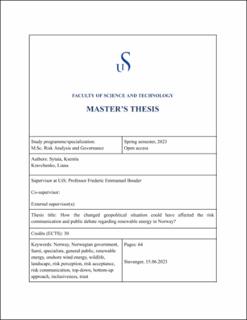| dc.description.abstract | This Master Thesis has explored the relationship between risk communication regarding onshore wind energy in Norway and external circumstances. Land-based wind turbines are a highly polarized topic among the citizens, and the development of this renewable energy has encountered substantial opposition throughout the nation. One faction comprises the governing bodies advocating for reducing fossil fuel usage and increasing the adoption of renewable energy sources. Conversely, the local inhabitants and other groups express concerns that installing wind turbines adversely impacts the natural environment. However, a chain of events including prohibitive electricity prices in Norway, unprecedented energy demand in Europe, and the Russian invasion of Ukraine, has led to looking at windmills from a different angle.
Based on the research question “How the changed geopolitical situation could have affected the risk communication and public debate regarding renewable energy in Norway?”, 3 hypotheses were formulated:
1) The effectiveness of a bottom-up inclusive approach to risk communication regarding onshore wind turbines in Norway surpasses that of a top-down approach.
2) Minimal involvement of interest groups in risk communication contributes to achieving successful outcomes of that communication.
3) A potential shortage of energy sources within the country, resulting from external factors, may contribute to a rise in the willingness to accept risks.
A combination of two methods has been employed to conduct the research. In 2019, Norwegian Water Resources and Energy Directorate issued a proposal for a nationwide framework on onshore wind power, which played a pivotal role in stimulating intense debates and protests in Norway. Therefore, we recognized the significance of conducting a content analysis to examine the fundamental factors that trigger such a strong societal reaction. To monitor and evaluate changes in risk communication among key stakeholders as well as shape their narrative, discourse analysis is chosen as the most suitable approach.
The results of this research provide compelling evidence indicating that a bottom-up inclusive approach to risk communication regarding onshore wind energy in Norway has proven to be much more effective, despite the fact that traditionally the Norwegian government uses top-down risk communication. Among other findings is that minimal involvement of interest groups in risk communication doesn’t contribute to positive results. On the contrary, in certain circumstances it can lead to societal radicalization, and heightened tension between stakeholders, thus jeopardizing the whole risk communication. The interplay between rising prices and the increasing impact of the Eastern region on energy demand in Europe has noticeably affected how people perceive risks associated with alternative energy sources. Specifically, the public's viewpoint regarding the development of onshore wind farms has shifted from strong disagreement to somewhat agreement. | |
